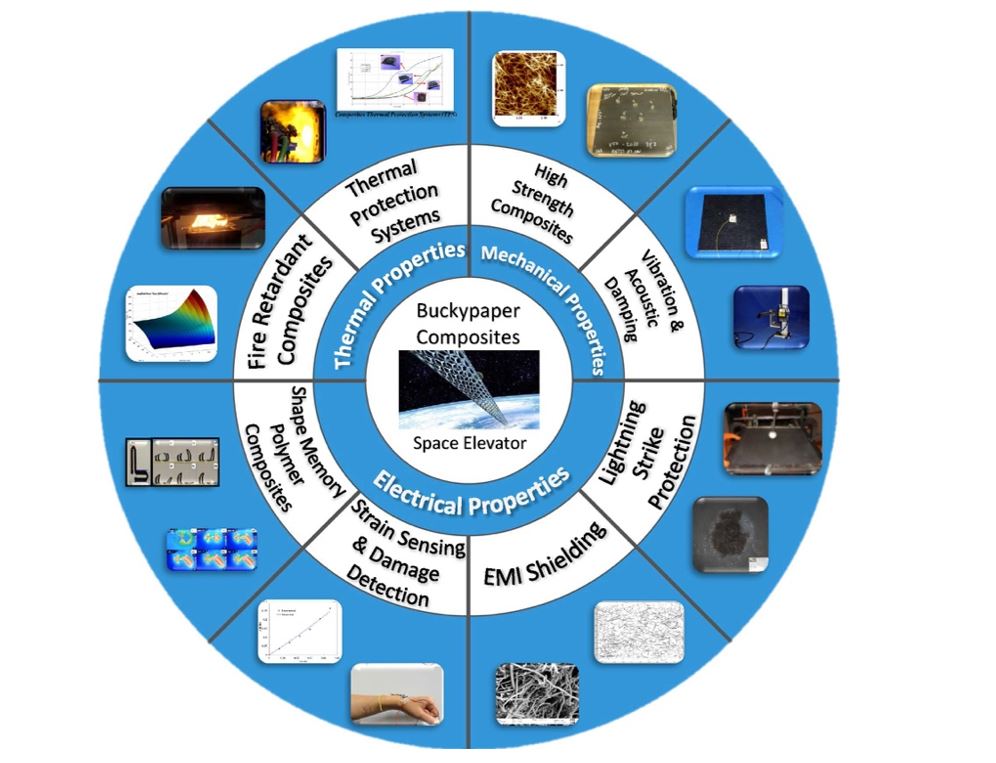Video Article Open Access
Science and Technology of Multi-functional Buckypaper Composites
Jihua Gou*, Xin Wang, Jayanta Kapat
Department of Mechanical and Aerospace Engineering, University of Central Florida, Orlando, Florida 32816, USA
Vid. Proc. Adv. Mater., Volume 2, Article ID 2021-0181 (2021)
DOI: 10.5185/vpoam.2021.0181
Publication Date (Web): 13 Feb 2021
Copyright © IAAM
Graphical Abstract

Abstract
Inspired by the Eiffel Tower in Paris, Russian scientist Konstantin Tsiolkovsky came up with the idea of space elevator in 1985. The space elevator was conceived as a space cable, also known as space tether between the equator and a counterweight in outer space. The center of mass of the system is above the geostationary orbit level to enable to generate a centrifugal force from the Earth’s rotation to overcome the gravitational force by Earth. Carbon nanotube has been considered as a candidate material for the space cable due to its high specific strength. However, there are significant challenges in making the space cable from carbon nanotubes. In our research work, we have explored the buckypaper as a reinforcement to make carbon nanotube-based composite materials. The buckypaper is preformed as a sheet or mat through a sheet forming process governed by the hydrodynamic behaviour of carbon nanotubes in an aqueous solution. The microstructure and nanostructure of the buckypaper is tailored towards the fabrication of the buckypaper composites with various types of matrix materials including the polymer matrix, metal matrix and ceramic matrix. The buckypaper composites potentially can meet the requirements of property and performance targets of space cable. In our study, we have systematically investigated the processing-structure-property-performance interrelationships of the buckypaper composites through the combination of experimental and computational approach. The key parameters to qualify the buckypaper to be a reinforcement material include carbon nanotube surface, carbon nanotube orientation, scalability of the buckypaper making process, and manufacturability of the composites reinforced with the buckypaper. We have conducted fundamental studies on the hydro-mechanical process dominated by the drainage under vacuum force, oriented shear and alignment under external fields, and fluid turbulence in order to optimize the microstructure and nanostructure of the buckypaper and to scale up the paper making process towards roll-to-roll manufacturing of the large-size buckypaper for real-life applications. The buckypaper offers excellent mechanical, electrical, and thermal transport properties close to individual carbon nanotubes. In our research work, we have further studied the potential of the buckypaper for multifunctional composites by incorporating it to the matrix through conventional composites manufacturing processes. Several potential applications of the buckypaper composites are illustrated; in particular, high strength composites, vibrational and acoustic damping, electro-magnetic interference shielding, lightning strike protection, fire retardancy, thermal protection, strain sensing and damage detection, and shape memory polymer composites are discussed. The future research directions for the buckypaper composites are also presented.
Keywords
Space elevator, carbon nanotube, buckypaper, nanocomposite material, multifunctional composites.
Acknowledgement
We acknowledge the funding support from National Science Foundation, Office of Naval Research, and Federal Aviation Administration in the United States of America.
References
- X. Wang, J. F. Li, H. N. Song, H. Huang, J. Gou, Applied Materials and Interfaces, 2018, 10, 7371
- Y. Z. Cai, L. Q. Chen, H. Y. Yang, J. Gou, L. F. Cheng, X. W. Yin, H. F. Yin, Ceramics International, 2016, 42, 4984.
- H. B. Lu, F. Liang, J. Gou, W. M. Huang, J. S. Leng, Journal of Applied Physics, 2014, 115, 064907.
- J. F. Zhuge, J. Gou, R. H. Chen, J. Kapat, Composites Part A: Applied Science and Manufacturing, 2012, 43, 2278.
- J. Gou, Z. F. Zhao, Y. Tang, F. Liang, D. Firsich, J. C. Fielding, Composites Part B: Engineering, 2010, 41, 192.
Biography
Jihua Gou is Professor of Mechanical and Aerospace Engineering Department at the University of Central Florida located in Orlando, Florida in the United States. His composites research focuses on synthesis, processing and manufacturing, characterization and testing, and multi-scale modeling of composite materials for structural and multi-functional applications. He has been a PI or Co-PI for more than 25 research projects funded by government agencies and industries. He has published five book chapters and more than 100 journal papers and 110 conference papers in the field of composite materials. He holds four patents including U.S. Patent, European Patent, and World Intellectual Property Organization (WIPO) Patent. Dr. Gou has served as Associate Editor/Editorial Board Member of numerous scientific journals such as Journal of Composites Part B: Engineering, Journal of Composites Science, Journal of Smart and Nanomaterials, Journal of Advanced Composites and Hybrid Materials, etc. Dr. Gou received his bachelor’s degree in 1993 and his master’s degree in Material Science and Engineering in 1996 from Chongqing University, Chongqing, China. He earned his Ph.D. degree in Material Science and Engineering in 1999 from Shanghai Jiao Tong University, Shanghai, China. He also received a Ph.D. degree in Industrial Engineering in 2020 from Florida State University, Tallahassee, Florida, USA.
Dr. Gou is Graduate Program Director of the Mechanical and Aerospace Engineering Department offering three graduate programs including mechanical engineering, aerospace engineering and biomedical engineering with 150 doctoral students and 250 Master’s students. He is Co-founder of Segana LLC, a medical device startup company to enhance lung cancer radiation treatment. Segana LLC was selected as one of top 100 start-up companies across the United States of America for the “Start up of the Year” Award in 2019.
Video Proceedings of Advanced Materials

Upcoming Congress



